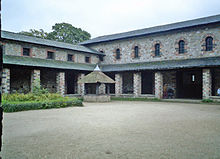Saalburg
[4] From 1967 to 1993, the museum was directed by the well-known archaeologist Dietwulf Baatz, whose many publications fostered a broad interest in provincial Roman archaeology well beyond specialist circles.Since prehistoric times, trade routes like the Lindenweg or Linienweg connected the Rhine-Main plain with the Usingen basin, which had been a centre of population since the Neolithic.Thus, it is no surprise that the mountain pass beside the Saalburg was first fortified by Roman troops during Domitian's wars against the Chatti (AD 81-96), when two simple earthen enclosures were erected (Schanzen A and B, located between the restored fort and the modern road).A preventive war under Caracalla, who marched against the Alamanni and their Chatti allies from Raetia and Mogontiacum in AD 213, lowered the Germanic pressure on the border only temporarily.The 3.25 hectares (8.0 acres) interior was enclosed by a double ditch and a mortared defensive wall; its external face was whitewashed and painted with a trompe-l'œil pattern of ashlar blocks.The rest of the fort's interior, today a park-like area of grass and trees, should be visualised as packed with further buildings: stables, magazines, workshops and, of course, the actual troop quarters, subdivided into contubernia.The parts of the vicus visible today are located mostly to the south of the fort, on both sides of the road that linked it with Nida, the regional capital and base of further garrison behind the border.These are followed along the road by the preserved basements and foundations (partially reconstructed) of residential houses and of - as believed in the time of the excavations - a mithraeum, a shrine to the Mithras, a deity popular among the Roman army.The museum exhibits a large collection of well-preserved military and domestic equipment from the Saalburg and other sites in the area as well as a series of architectural and terrain models.[13] The reerection of the fort in the late 19th and early 20th century led to a surge of interest by the local population, including visitors using the spa at Bad Homburg.






Saalburg (surname)SchanzenUpper Germanic LimesCohortsCoordinatesBad Homburg vor der HöheGermanyRoman fortmain ridge of the TaunusBad HomburgLimes GermanicusWehrheimUpper LimesUNESCO World HeritageAntoninus PiusJohannes GötzWilhelm IINassauarchaeologyTheodor MommsenarchaeologistsLouis JacobiHeinrich JacobiKaiser Wilhelm IIexcavationprehistoric timesRhine-MainUsingenNeolithicHöchstBundesstraßeDomitian'sChattiauxiliary troopscenturiaeBritainHadriancohortHeddernheimlegionaryWiesbadenButzbachpreventive warCaracallaAlamanniRaetiatrompe-l'œilashlarhorreumcontuberniaCastramansiomithraeumMithrasThermaehypocaustsigna militariaGermaniaJupiterWorld War IWayback Machine